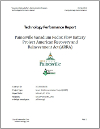Painesville Vanadium Redox Flow Battery Project American Recovery and Reinvestment Act (ARRA)
Feb. 20, 2015
City of Painesville, Ohio
The City of Painesville and Ashlawn Energy, LLC, undertook to build a one-megawatt, eight-hour, Vanadium Redox Flow Storage Battery under Department of Energy (DOE) Cooperative Agreement DE-OE0000233 for installation at the Painesville Municipal Power Plant in Painesville, Ohio. The financial February 1, 2010 assistance award initially provided $8,767,258.00 in funding, with $3,743,570.00 federal share, and $5,023,688.00 in recipient cost share. On November 15, 2010, the agreement was amended to reflect $9,462,623.00 in total funding, increasing federal share to $4,243,570.00 and recipient cost share to $5,219,053.00. As of this writing, total federal share expended is $4,193,609.41. Total non-federal cost share contribution is $4,578,728.99.
It was anticipated that the Painesville battery project would receive project matching funds from the state of Ohio under the Ohio Air Quality Development Authority Advanced Energy (OAQDA) forgivable loan program. After a change in Administration, Ohio's state priorities changed resulting in the states withdrawing funding for all OAQDA Advanced Energy projects, including the matching funding needed for this project in Painesville, OH.
A technology license was obtained from the inventor of the vanadium redox flow battery (VRFB), Dr. Maria Skyllas-Kazacos (University of New South Wales, Australia). The City of Painesville contracted with Ashlawn Energy, LLC to manage the development and fabrication of the battery as well as to prepare and provide all reporting to DOE. Ashlawn developed its supplier base, which included InnoVentures LLC, Concurrent Technologies Corporation (CTC), and others to build components and conduct prototype testing.
The City of Painesville contracted for and had built a new 4,900 square foot Butler building to house the battery at the site of its Municipal Power Plant at a cost of $432,828 using city funds as contribution included as part of project cost share. A number of prototype VRFB stacks were built and tested at CTC working up to a full sized 10,000 watt stack. Five patents were applied for improvements to the VRFB made by Ashlawn Energy engineers, and are currently pending at the USPTO. A drawing package, schedule, vendor selection, and economic business model was completed.


